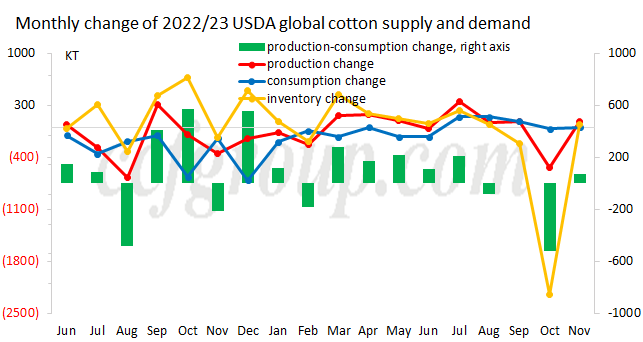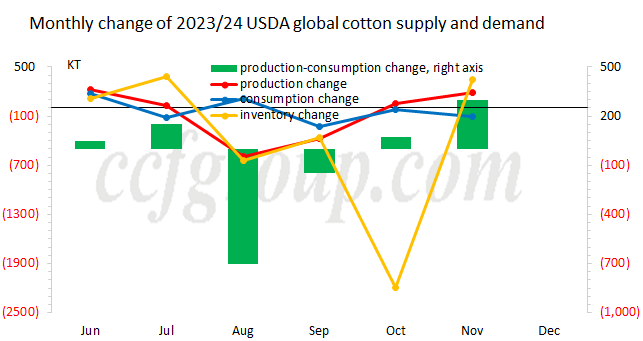Recently, USDA has released the global cotton supply and demand report for November, with only minor adjustments made. The production of Indian cotton was raised for the 2022/23 season, resulting in a slight increase in ending stocks and a minimal impact on the fundamentals. For the 2023/24 season, the adjustments were bearish somewhat, with an upward revision to US cotton production and lower consumption expectations based on the current market conditions. Although global ending stocks were revised up compared to the previous month, the overall expectation for the 2023/24 season was still destocking.
In detail, the USDA report for November only made minor adjustments to the global cotton supply and demand for the 2022/23 season, with production raised by 80,000 tons, mainly from a 70,000 ton increase in India. The adjustment was based on the Cotton Advisory Board of India's increase of 300,000 bales of production in 2022/23 season while India's beginning stocks were decreased by 40,000 tons, resulting in an ending stock increase of 20,000 tons. Other countries were kept in line with previous estimates, without significant adjustments. Looking at the annual figures, both global imports and consumption of cotton were down compared to the previous season, while production has increased significantly, leading to a considerable accumulation of stocks and pressure on the beginning stocks for the 2023/24 season.

For the 2023/24 season, the monthly adjustment was also minor, with production up by 190,000 tons mostly due to an upward revision to the US production. Imports were raised by 20,000 tons, with China up by 110,000 tons and Turkey and Vietnam down by 20,000 tons and 40,000 tons, respectively, based on current downstream conditions. Estimated global consumption was reduced by 110,000 tons, with the US, Turkey, and Vietnam each down by 20,000 tons, 20,000 tons, and 40,000 tons. Overall, the situation showed an increase in production and a decrease in consumption, leaning towards a bearish adjustment, resulting in an ending stock increase of 340,000 tons, although there is still an overall destocking expectation for the 2023/24 season.

Moreover, the surprise adjustment in this month's USDA balance table was the upward revision of US cotton production. Since August, the market has been expecting a decrease in US cotton production, and this expectation provided support to cotton prices with three consecutive months of downward production adjustments. However, it also raised doubts about the accuracy of the data. Last month, US cotton production was down to 2.79 million tons in October, reaching a historical low. However, tracking the data, US cotton's excellent rate was still acceptable, and the weather conditions have improved, with growth progress not much different from previous years, and abandonment rates lower than last year, suggesting that the decrease in production may not be as significant as previously adjusted. This time, the USDA raised the yield from 767 pounds per hectare to 783 pounds per hectare, with a slight reduction in the abandonment rate, making the upward adjustment in production reasonable.
In addition, the market sentiment was also affected by China's cotton imports. Since the 2023/24 season, US cotton export sales have been lukewarm due to the global sluggish consumption, and the recent improvement mainly came from sales with China. As of November 2, the weekly US upland cotton export sales for 2023/24 were 89,600 tons, a 14% drop from the previous week, with China accounting for 66% of the total sales at 59,000 tons. This year, due to the improvement of China-Australia relations and the significant increase in Brazil's cotton production, imports from Brazil and Australia have also increased substantially. As the continuous state cotton auction since October gradually reduced the national reserved cotton stocks, the market speculated that China will continue to increase its imports. Therefore, with China's impressive import performance in the past few weeks, the upward adjustment of China's cotton imports has also closely affected the market sentiment, as China is the largest importer and consumer of cotton.